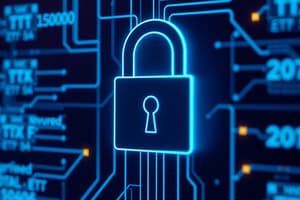Podcast
Questions and Answers
What is the primary role of security professionals in the digital world?
What is the primary role of security professionals in the digital world?
- Safeguarding the confidentiality, integrity, and availability of data. (correct)
- Developing new software applications.
- Marketing organizational products.
- Managing network infrastructure.
Which of the following describes data at rest?
Which of the following describes data at rest?
- Data being actively processed by a computer.
- Data being viewed on a screen.
- Data moving through a network.
- Data stored on physical or virtual mediums. (correct)
What is the main purpose of encrypting data?
What is the main purpose of encrypting data?
- To make data processing faster.
- To protect data from unauthorized access. (correct)
- To organize data into databases.
- To compress data for efficient storage.
In which state is data most vulnerable to interception and compromise as it moves across networks?
In which state is data most vulnerable to interception and compromise as it moves across networks?
Which scenario describes data in use?
Which scenario describes data in use?
What does DLP stand for in the context of data security?
What does DLP stand for in the context of data security?
Which type of DLP system involves installing software agents on endpoints?
Which type of DLP system involves installing software agents on endpoints?
What method does a Network based DLP system use to identify sensitive data?
What method does a Network based DLP system use to identify sensitive data?
What is the purpose of pattern matching in DLP systems?
What is the purpose of pattern matching in DLP systems?
What is the primary goal of data minimization?
What is the primary goal of data minimization?
What does deidentification involve?
What does deidentification involve?
Which of the following is a data minimization technique?
Which of the following is a data minimization technique?
What is the purpose of hashing in data protection?
What is the purpose of hashing in data protection?
What does masking do in the context of data protection?
What does masking do in the context of data protection?
What is the purpose of implementing access restrictions?
What is the purpose of implementing access restrictions?
What do geographic restrictions control?
What do geographic restrictions control?
What is the goal of permission restrictions?
What is the goal of permission restrictions?
What is network segmentation?
What is network segmentation?
What is the primary benefit of network segmentation?
What is the primary benefit of network segmentation?
What does system isolation involve?
What does system isolation involve?
Which type of data is particularly suited to System Isolation?
Which type of data is particularly suited to System Isolation?
What is the main purpose of encryption?
What is the main purpose of encryption?
What is the role of pattern matching in Data Loss Prevention (DLP)?
What is the role of pattern matching in Data Loss Prevention (DLP)?
Which of the following is a key principle of data minimization?
Which of the following is a key principle of data minimization?
What does 'deidentification' aim to achieve in data handling?
What does 'deidentification' aim to achieve in data handling?
Flashcards
Data Protection
Data Protection
Protecting the confidentiality, integrity, and availability of data.
Data at Rest
Data at Rest
Data stored on physical or virtual mediums.
Data in Transit
Data in Transit
Data moving through network environments.
Data in Use
Data in Use
Signup and view all the flashcards
Data Encryption
Data Encryption
Signup and view all the flashcards
Data Loss Prevention (DLP)
Data Loss Prevention (DLP)
Signup and view all the flashcards
Agent-Based DLP
Agent-Based DLP
Signup and view all the flashcards
Network-Based DLP
Network-Based DLP
Signup and view all the flashcards
Pattern Matching (DLP)
Pattern Matching (DLP)
Signup and view all the flashcards
Watermarking (DLP)
Watermarking (DLP)
Signup and view all the flashcards
Data Minimization
Data Minimization
Signup and view all the flashcards
Deidentification
Deidentification
Signup and view all the flashcards
Hashing
Hashing
Signup and view all the flashcards
Tokenization
Tokenization
Signup and view all the flashcards
Masking
Masking
Signup and view all the flashcards
Geographic Restrictions
Geographic Restrictions
Signup and view all the flashcards
Permission Restrictions
Permission Restrictions
Signup and view all the flashcards
Network Segmentation
Network Segmentation
Signup and view all the flashcards
System Isolation
System Isolation
Signup and view all the flashcards
Study Notes
- Security professionals protect data confidentiality, integrity, and availability in the digital world.
- Data protection ensures organizational secrets and customer details are not compromised.
- Security professionals protect data in three states: at rest, in transit, and in use.
- Data at rest is stored on physical or virtual mediums and is vulnerable to unauthorized access.
- Data in transit is dynamic data moving through networks and is susceptible to interception.
- Data in use is active data engaged by computing processes and stored in volatile memory.
- Understanding these states is essential for effective data protection strategies.
Understanding Data Encryption
- Encryption protects sensitive information from unauthorized access by encoding data.
- Encryption uses mathematical algorithms to transform data into an unreadable format.
- Encryption secures data both in transit and at rest.
- Encrypting data in transit protects it as it moves across networks.
- Encrypting data at rest protects stored information.
- Encryption addresses the risk of data being intercepted or stolen.
- Email and file transfers are examples of data in transit.
- Stored information is data at rest.
Data Loss Prevention Strategies
- Data Loss Prevention (DLP) systems safeguard an organization's sensitive information.
- DLP strategies are implemented to enforce information handling policies and reduce data breaches.
- DLP systems locate and monitor sensitive data to ensure its security when stored and during transmission.
- Agent-based DLP systems install software agents to search for sensitive information on endpoints.
- Agent-based systems monitor user actions and block activities that could lead to data leaks.
- Network-based DLP systems scan outbound network traffic to block the transmission of unsecured sensitive data.
- These are usually deployed as appliances within the network infrastructure, overseeing all network activity to prevent data leaks.
- DLP systems identify sensitive data using pattern matching and watermarking.
- Pattern matching recognizes structured data like credit card numbers based on their formats.
- Watermarking uses electronic tags to track unauthorized movement or use of documents and data.
- DLP strategies help organizations maintain data privacy and integrity and comply with regulations.
Principles of Data Minimization
- Data minimization reduces the risk of unwanted exposure of sensitive information.
- Data minimization limits the storage and use of personal information to what's strictly necessary.
- Deidentification protects individual privacy by removing or altering personal identifiers in datasets.
- Deidentification creates anonymity without compromising data utility.
- Hashing converts data into a fixed-size string of characters, which is practically irreversible.
- Tokenization replaces sensitive data elements with non-sensitive equivalents.
- Tokens can be mapped back to the original data through a secure tokenization system.
- Masking obscures specific data within a dataset, allowing partial data exposure.
- Using the last four digits of a credit card number is an example of masking.
- Each method serves to minimize the accessibility of sensitive data, preserving privacy while maintaining functionality.
Implementing Access Restrictions
- Enforcing access restrictions is critical in safeguarding sensitive data and resources.
- Geographic restrictions control the physical location from which data can be accessed.
- Permission restrictions define access levels based on roles or authorization.
- Integrating these security measures minimizes the risks associated with data breaches and cyber-attacks.
- They also maintain confidentiality, integrity, and availability of sensitive information.
Network Segmentation and Isolation
- Network segmentation divides a larger network into smaller subnetworks.
- Each segment can be managed and secured independently.
- Segmentation helps contain security breaches within a limited area.
- Segmentation improves security, network performance, and management.
- System isolation restricts a system's connectivity to prevent access from external sources.
- Isolation is crucial for highly sensitive systems that house critical data.
- Limiting exposure to only the most essential interactions or completely cutting off remote access ensures the highest level of security for systems.
Studying That Suits You
Use AI to generate personalized quizzes and flashcards to suit your learning preferences.




